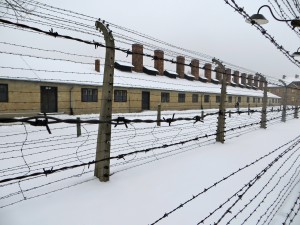Posted November 28, 2013
By SAMANTHA LUCCI
KRAKOW, Poland – “I do not hold anything against them,” David Mermelstein, a Holocaust survivor of the World War II Nazi death camp at Auschwitz, said of Nazi descendants. “I have compassion for them. They are not their grandparents’ generation, and yet they must live with their actions.”
I met Mr. Mermelstein when we were paired up through the Holocaust Survivor Support Internship Program (HSSIP) offered as a course at the University of Miami. His role was to tell his story; mine was to record it.
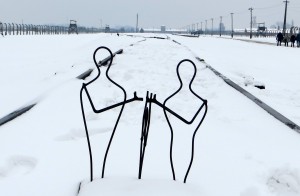
Human figurines made out of iron placed as a memorial at the end of the train tracks running through Auschwitz-Birkenau. Nazis used the tracks to bring captives to the camps during World War II (Photo by Samantha Lucci).
As I sat looking out the window on a bus on my way from the airport to our hostel here, his words came to mind. It was dark. There was a fresh layer of snow on the ground, making everything seem quieter, more solemn.
Maybe that was just a product of my imagination, but it seemed real at the time. To me, winter has always been associated with happiness. My birthday is in the winter. The holidays are during the winter. The colder months of the year are synonymous with sledding and snow ball fights, trips to the ice rink, hot chocolate and nights spent working on puzzles by the warmth of a living room fire.
But, not there. Not on that frigid bus in the dead of night, in the dead of winter; my breath immediately visible, then disappearing in foggy wisps.
There, I hated winter. I hated it, because all I could think about was death.
Even the living seemed, somehow, less than alive to me. At each stop, someone would get on or off the bus. Some were young, some old. Male and female. It didn’t matter. I thought of them all as monsters. I silently interrogated them: was your grandfather a Nazi? Do you believe what they believed; do you support what they did?
No matter who they actually were or were not, I found myself labeling them as the grandsons and granddaughters of Polish Nazis. As if they had caused the world-scale tragedy and desolation; as if they had brought on the impenetrable cold and the death.
It wasn’t until I remembered that conversation with Mr. Mermelstein that I realized how unfair a judgment I was making and how wrong I was. Most Poles didn’t support the Nazis during World War II. I remembered that conversation with Mr. Mermelstein and I realized that I was the one who was guilty of hate, not them.
How is it that a man who lived through hell on earth— through the depths of human despair and suffering—could still have a heart so big?
* * *
The day of my first scheduled visit with Mr. Mermelstein I had been nervous. I second-guessed everything. What should I wear? What should I bring? What if he didn’t like me?
When I arrived, his wife Irene, also a survivor of Auschwitz, met me at the door. We spent a few minutes talking about dragon fruits and persimmons and rambutans—the gifts I had chosen to bring for fear of not keeping Kosher. We were all aware of the weight to come. We used small talk to delay, to give us a moment to know each other impersonally before launching into such a deeply personal testimony. I entered the privacy of their home, and would soon dare to enter the privacy of their past, of their pain.
How could I prepare myself for something like that?
Mr. Mermelstein has made it his mission to make the terrors and the anguish of his experiences—unique to himself, but still shared, in some way, by millions of others—public.
“We must not forget,” he said to me. “We cannot let it happen again.”
* * *
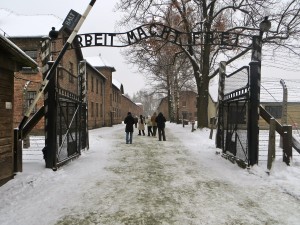
The gates at the entrance to Auschwitz reading “Arbeit MAcht Frei,” or “work makes you free.” The Nazis used this message to lull their prisoners into a false sense of security (Photo by Samantha Lucci).
Arbeit Macht Frei. “Work makes you free.”
The infamous sign, a hallmark of Nazi propaganda. Almost everyone has heard of it, but that doesn’t prepare you for the chilling sensation of seeing its message on bold, wrought iron display above the entrance to the main housing compound at Auschwitz.
The curve of its mold is reminiscent of a flowing musical staff. I could have found this thought lighthearted, maybe even inspiring or joyful under different circumstances. Instead, I found it sickening.
I recalled learning in one of my classes about a technique the Nazis would use to lull their prisoners into a state of compliance by creating a false sense of security.
Before the loads of people arriving at death camps like Auschwitz got too heavy towards the end of the war, guards would pick skilled musicians from the ranks of their peers and force them to play music to welcome the newcomers to the compound.
They made it a celebration.
Inside Auschwitz, I walked along the barbed wire fences that surrounded the camp. I learned about the Nazi plan for extermination. Through glass display windows, I saw the countless eyeglasses, shoes, and pieces of luggage that had been stripped from the prisoners. On some, the names of the owners were still legible.
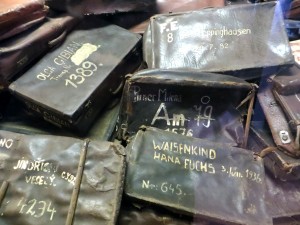
The museum inside Auschwitz houses countless pieces of luggage, among other items, that the Nazis stripped from their prisoners upon entrance to the camp. These items act as a memorial to the victims that suffered in the camp (Photo by Samantha Lucci).
Olga Gibian, who were you? How could this happen to you?
In rows upon rows of mug shots, I looked into the inconsolable eyes of captives; saw their fragile, emaciated bodies in crude black-and-white snapshots.
On the last stop of our tour there, before we went on to the barracks at Birkenau camp, I entered the crematorium.
* * *
Mr. Mermelstein he had told me about the moment when he experienced true clarity about his situation.
Upon arriving at Auschwitz, after passing the first selection process and being assigned to his barracks, he and the other prisoners pressed the Kapo—a Jew appointed by Nazi guards to keep the others in line—for answers.
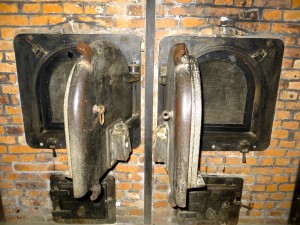
Two of the ovens that burned the bodies of victims of Auschwitz camp. The smoke Mr. Mermelstein and the others saw rising from the chimneys likely came from these ovens (Photo by Samantha Lucci).
“’Where are our mothers and our sisters? Our daughters? Our children? Our parents and grandparents?’” Mr. Mermelstein said they had asked. “’When will we see them again?’”
The Kapo had demanded their attention and directed them to the opening of the barrack. He pointed to the chimney in the distance, and the smoke that choked out of its stacks, seeping into and blending with the sky.
“You see the chimney? You see the smoke?” he asked them. “There are no parents. There are no sisters.”
According to Mr. Mermelstein, that was it. The Kapo said no more. They gaped at him, then they gaped at each other, disbelieving of the implicit meaning of his words.
* * *
From Auschwitz, we took vans to Birkenau, the sister camp, designated more for work than extermination. Here, the wind picked up. Tour groups huddled close together to protect against the bitter cold.
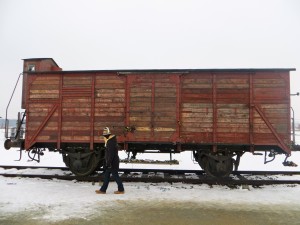
One of the cattle cars used by Nazis to transport their captives to Auschwitz-Birkenau camp. Up to 100 people would fit into one of these at one time (Photo by Samantha Lucci).
An out-of-use set of train tracks ran through the center of the camp. On them, a cattle car was parked.
“This car, and many others, was used to transport Jews, Poles, and other targets of the Nazi’s Final Solution to Birkenau for work, or to Auschwitz for death,” our guide told us. “Eighty to 100 people would fit in one car. There was no room to sit. Many died on the way here, right where they stood.”
* * *
For one of our sessions, I went with Mr. Mermelstein to temple. At one point during the ceremony, the rabbi offered his congregation the opportunity to stand up to pay tribute to an absent loved one. Several people rose to their feet, including Mr. Mermelstein.
Looking up, I asked him whom he stood for and why.
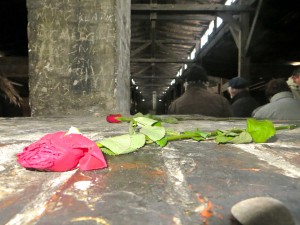
A flattened rose left by an anonymous visitor rests on one of the empty bunks in the barracks at Birkenau camp (Photo by Samantha Lucci).
“For the six million people who died in the Holocaust,” he said. “For my friends, my family and for my neighbors. For the people I never met. I lived and they didn’t. I honor them because they have no one else.”
So, then, I stood too.
* * *
I deliberately chose to go to Auschwitz-Birkenau in the middle of winter because that’s how so many people experienced it, whether physically or mentally.
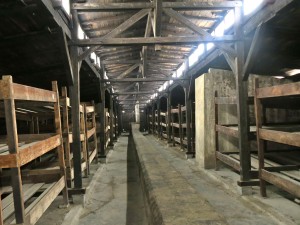
The inside of one set of barracks depicts the rows of empty bunks shared by prisoners of Birkenau camp during World War II. Up to 10 prisoners slept in each bunk at one time, bare of any mattresses or bedding (Photo by Samantha Lucci).
They marched nearly barefoot and bare-skinned through freezing temperatures, so many to their deaths. They trembled, 10 to a bunk, through cold, dark nights that did not end with the coming of light.
I do not compare my experience to that of the victims of the Holocaust. I simply wanted to transport myself back to a time and a place that I will never fully understand, but that I must remember; for people who I believe deserve to be honored.
At the end of our tour, our guide led us along the tracks to the edge of Birkenau camp, bordering the forest.
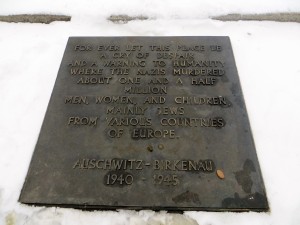
Plaques arranged between the end of the train tracks and the edge of the forest at Birkenau camp serve as a memorial to the victims of the Holocaust. Each plaque has a message of remembrance translated in each of the languages of the victims that came to Auschwitz-Birkenau (Photo by Samantha Lucci).
Plaques with messages written in the different languages of the victims at Auschwitz-Birkenau were placed here to honor both the dead and the living.
The plaques read: “Forever let this place be a cry of despair and a warning to humanity, where the Nazis murdered about one and a half million men, women and children mainly Jews, from various countries of Europe.”
“We must not forget,” Mr. Mermelstein said. “We cannot let it happen again.”

